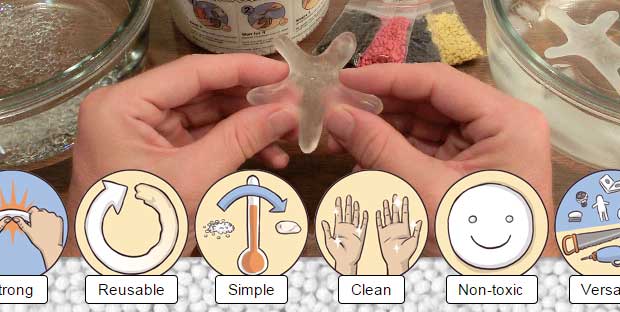While browsing my Facebook feed I stumbled upon Plastimake. Originating from Australia, Plastimake is essentially a commercial moldable plastic that softens in hot water and hardens in cold water.
The website features hundreds of sculptures and projects made from these small plastic pellets, but what caught my attention about this product in particular was its implications on sustainability. As seen in the introductory Youtube video, many people have started fixing certain broken household objects with this product rather than throwing them away. This loosely links back to our conversation in class about reusing and making the most of product on hand rather than buying our way to sustainability through eco-friendly products.
Plastimake is essentially a cradle to cradle product, boasting unlimited usage as all consumers need to do when they want to change the product is to heat it up and mould it again. But in the event that consumer do choose to throw it away, it biodegrades into water and carbon dioxide.
Although the facts remain questionable as the website relays very limited information, this still seems like an interesting step towards sustainability.


This is very interesting that people can use it to fix household appliances. It is great environmentally and economically as people do not need to replace and dispose of old items. It is even greater that the product can decompose. However if it decomposes into water and carbon dioxide, what about the emissions released? It always comes down to the life cycle analysis of the product to see how environmentally friendly it actually is. Has the company looked into those emissions?
Hey Kristen,
Thanks for reading my article! The company actually doesn’t provide a lot of information about how it’s environmentally friendly beyond simply stating that it is so. To me it’s pretty sketchy how they’ve failed to give the public any verifiable information, however personally I feel that one saving grace would be that their product can be reused an unlimited number of time (allegedly). But looking a little more into the product, polycaprolactone, it seems it is a chemically derived from crude oil. I’m not a chemist but I’m thinking the degradation process is probably a little more complex than what they’re leading consumers to believe. Hopefully if the product catches the attention of some more erudite bloggers we’ll start getting some more detailed answers about their emissions and other environmental standards.
Hey Sarah!
Thanks for the great article and tying in sustainability to this. I also heard about this through Facebook and I honestly just thought it was a pretty innovative innovation when I first saw it – almost like adult Play-Doh! Also appreciate that the company looked at the product’s life cycle and found a way for it to be biodegradable. However, though it is quite interesting, I wonder about the process actually used to create the product. It sounds rather complex to create something that is able to be reused over and over again without breaking down. Moreover, it could also involve some toxic chemicals that are harmful to the environment. 🙁
Warm Regards,
Katie